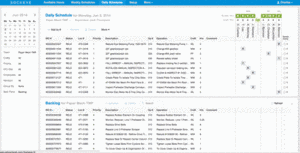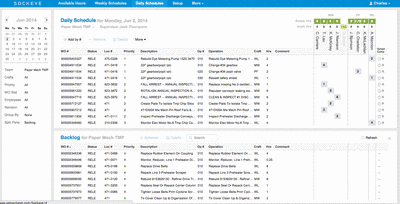 Every organization should use either a CMMS or work order management system to manage preventative maintenance work requests. However, facilities maintenance planning and scheduling effort may not always be delivered as intended.
Every organization should use either a CMMS or work order management system to manage preventative maintenance work requests. However, facilities maintenance planning and scheduling effort may not always be delivered as intended.
Similar to running an effective meeting or being good at supervising, planning and scheduling are acquired skills that can be developed and cultivated through training, use of the proper tools, and discipline. If your facilities maintenance (FM) organization is having difficulties with work order management – particularly in the critical area of planning and scheduling – know that planning traits and skills are not inborn; they must be taught.
Let’s begin with some general definitions. Planning defines the what and the how about the job, scheduling determines the who and the when.
Most of us agree on the many benefits of effective work planning and scheduling: greater labor productivity, better customer service, reduced overtime, minimal inventory, and so on. But if this isn’t happening as it should in your maintenance organization, what’s going wrong?
To begin, and as a minimum requirement, your organization should be using either a computerized maintenance management system (CMMS) or some other kind of work order (WO) management system to manage preventative maintenance (PM) work requests and work orders. How to choose one of these systems is a whole different discussion. For now, let’s assume you have one of these systems in place.
Here are nine common reasons why your facilities maintenance planning and scheduling effort may not be delivering as intended.
1. Wrong system tools for the job.
Your CMMS or WO management system is too complicated and time consuming or it lacks some of the key features for proper planning and scheduling. These features include a bona fide scheduling function, provision for estimated hours in the work order records, detailed job plans, available labor and similar inputs that capture the details of the job plan and the schedule. What happens if your system lacks these input and reporting capabilities? Your staff inevitably turns to spreadsheets and other workarounds outside the system to do their jobs, which wastes a lot of time. The solution is to either install a new system or get an add-on program that provides the right features so your planning staff can ditch the spreadsheets and do their work with the right tools.
2. Insufficient staff.
A rule of thumb is one planner/scheduler for every 20 workers to be scheduled. This can vary based on the complexity of the work, but start with 1:20 and adjust as needed. Remember, if you do not have enough people to do the job, the job will not get done, period.
3. Insufficient skills.
Headcount alone is not enough to assure success, of course. Planners in particular need proper training and/or experience for job estimating and job plans. Schedulers need to be adept with the CMMS. Both need some people skills so they can work well with the shops to make the schedules realistic and likely to be followed.
4. Incorrect role definition.
The planner/scheduler role should be on par with a supervisor and ideally report to a separate manager. Planner/schedulers do not work for the supervisors. They are not clerks. This understanding can help avoid conflict and reinforce the concept that supervisors should focus on supervising. All too often, valuable supervisor time is wasted on planning and scheduling and the work suffers as a consequence.
5. No procedures to follow or staff lacks the discipline to follow them.
The entire planning and scheduling work cycle should be documented with decision points and responsibilities so all players understand how it works and what their role is in it.
6. Shops resist following the schedule and the job plans.
This could be due to planner/scheduler credibility issues, weak department management or lack of training, but it’s almost always due to a lack of the shop supervisor’s ownership of the schedule. Shop supervisors need to be involved in planning and scheduling to the extent that they 'own’ their schedules. This may be part of a larger cultural issue so care must be taken to get to the root of any compliance issues before taking corrective action.
7. No metrics for reporting schedule compliance and attainment.
You can’t manage what you can’t measure, so it is vital to measure and report schedule compliance (scheduled versus actual job completion date) and actual versus estimated hours at, a minimum, to gauge planning and scheduling effectiveness.
8. No management support.
It doesn’t matter what the report says if the manager doesn’t read it. The ball is in management’s court after the report is made. How to respond to metrics is a separate story all in itself, but the proper management approach will add value to the situation for customers who benefit from your maintenance and planning efforts.
9. No recognition of the financial impact of low productivity and poor customer service due to poor planning and scheduling.
Those holding the reins and the checkbook must recognize how crucial planning and scheduling is to the financial health of the operation. Failure to do so is the equivalent of expecting an athlete to perform well on a diet of junk food and alcohol.
Planning and scheduling is the brains of your operation. With the right tools, it can also be the central nervous system. Done well, planning and schedule gets all the right players moving in the right directions to get the right work done at the right time.
What’s your experience with planning and scheduling and the lessons you’ve learned along the way? What do you do to maintain a culture that supports an effective planning and scheduling operation?
Source: Plant Engineering






